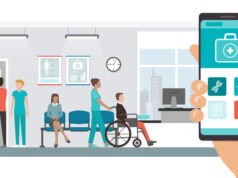My colleagues at NHSX are starting to uncover the significant opportunities offered by Artificial Intelligence (AI) solutions for keeping people healthy, improving care and saving lives. In the field of diagnostics alone, we are seeing capabilities develop in areas such as rapid image recognition, symptom checking and risk stratification. AI could help, for example, to personalise health screening and treatments for cancer, eye disease and a range of other conditions. Furthermore, it’s not just patients who can benefit, but also clinicians, enabling them to make the best use of their expertise, informing their decisions and saving time.
The UK is not alone, Europe is also looking closely at how this fast-developing area can change people’s lives, particularly in the field of healthcare.
Commonalities between the EU and UK approach to AI
The aspiration in Europe is that technology and industrial strengths can be combined with a world class digital infrastructure and regulatory framework to become a global leader in the data economy. To deliver on these opportunities, the European Commission is looking at developing an ecosystem of excellence that supports the rapid and ethical development of AI in Europe from research and innovation, through to incentivising adoption of solutions including by SMEs. In its upcoming White Paper on AI, the Commission is likely to cite benefits in healthcare for citizens through more precise diagnosis and prevention of diseases and generation of new medicines; as well as opportunities for businesses to develop a new generation of healthcare products and services.
UK interests are aligned – the ‘AI and Data Mission’ was announced this year as one of the UK government’s Industrial Strategy’s Grand Challenges. It aims to put the UK at the forefront of the use of AI and data in early diagnosis and treatment claiming that “within 15 years better use of AI and data could result in over 50,000 more people each year having their cancers diagnosed at an early rather than late stage. This would mean around 20,000 fewer people dying within 5 years of their diagnosis compared to today.”
Further, the NHS has recognised that AI can help with the next round of game changing medical breakthroughs. We have already seen algorithms that can compare tens of thousands of drug compounds in a matter of weeks instead of years. Now, there are practical opportunities to use AI and data to accelerate medical research in early diagnosis, to improve prevention and treatment of disease. For example, a pilot is underway at the East Midlands Radiology Consortium to trial data-driven tools to complement the expert judgement of frontline staff to read mammograms. The trial aims to support radiologists with one of the most consequential decisions they make – whether to recall a patient.
Alongside the opportunities, both the UK and the EU have recognised that the use of AI solutions involves a number of ethical and regulatory challenges, particularly where decisions made can have a significant impact on the life and health of patients involved. To maintain public trust, it will be critical to develop clear standards and frameworks alongside technological developments.
What is next in 2020?
The UK has now formally left the EU. During the Brexit implementation period that lasts until the end of 2020, the UK will follow EU law and so will continue to work with the EU in many of the same ways as before. The EU and UK will shortly begin to negotiate their future relationship, which will take effect from January 2021. Whatever the outcome, there will continue to be common opportunities and issues that know no border. AI is certainly one of them.
An immediate opportunity for cooperation is around the urgent and important matter of delivering the exciting benefits of AI within an ethical and trustworthy framework. We believe that the European Commission’s White Paper on AI will look towards possible regulation of AI. It will most likely propose a differentiated risk-based approach around two factors: sector and use of the AI application. Healthcare, understandably, often falls into both categories and is likely to be subject to mandatory requirements in the development and deployment of AI tools.
This will be one of the first pieces of legislation that the UK follows as a third county, in its new era outside the EU. However the future EU-UK relationship looks, there are opportunities for sharing best practice and collaborating, across nations, to translate the potential of AI into benefits for people.
NHS experience of value to the EU
The NHS has relevant expertise that could be of assistance to European partners. These are some examples of where the UK could, despite Brexit, continue to share experience to deliver on our aligned opportunities and aims:
Coordination – NHSX was launched in 2018 and is designed to consolidate the strategy, leadership and technical expertise to the UK’s public sector digital transformation project. To coordinate diffusion of technologies across the health service, the newly created NHS AI lab is supporting and developing the ecosystem to bring together policies, partners and programmes to develop and deploy safe, effective AI applications. The Lab will also support a £140 million AI award designed to speed up testing and adoption of the most promising tools with scale-up potential. The learning from this work could help the EU bring together various national approaches to AI and support the emergence of a dynamic industry in Europe.
Standards – The NHS’ code of conduct for data-driven technologies was developed as a core resource for anyone involved in developing, deploying and using them. It provides practical guidance on all the issues surrounding regulation and access to data. Although the code has been recognised around the world as a leading source of guidance to ensure that AI is responsibly and safely used, it cannot be effective if not adopted. To support this, NHSX are working to develop an online self-assurance portal to facilitate compliance with the code, which involves mapping the regulatory journey and to assessing the need for regulation of AI in the future. This experience has already been shared with Europe’s team of experts working on European guidelines for trustworthy AI.
Leadership – A final, crucial element of a comprehensive AI approach, identified by both the EU and the UK, is leadership. The UK health secretary recently described what was required as a “change in culture so the doctor who leads her trust’s adoption of technology gets as much kudos as the doctor who leads her medical department”. NHSX’ Digital Ready Workforce Programme plans to give leaders, clinicians and managers the tools, confidence and understanding required to achieve this. The lessons learned here will be valuable to the EU as it continues its journey to achieve a common approach to AI.
In summary, AI is a strategic technology that offers many benefits for citizens and the economy provided it is human centric, ethical and respects fundamental values. Given the alignment between EU and UK values and approaches to date, despite Brexit moving us apart in many ways, we have a lot of learn from each other. My recommendation is to follow the Commission’s advice that if we want to maximise the benefits and address the challenges of AI, we should ‘work as one’ to promote the development and deployment of AI based on shared values.







